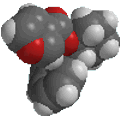 |
Chapter 15: Alcohols, Diols
and Alkyl Thiols |
 |
Diols
Nomenclature:
Diols are named systematically as poly-alcohols, e.g. HOCH2CH2OH
= 1,2-ethanediol, so the same nomenclature rules as for alcohols apply.
1,2-diols are often referred to as vicinal diols.
Functional group suffix = -diol (review)
Functional group prefix = dihydroxy-
|
|
|
|
|
ethanediol
|
1,2-propanediol
|
1,3-propanediol
|
cis-1,2-cyclohexanediol |
|
ethylene glycol
|
propylene glycol
|
|
|
QUESTION In cis-1,2-cyclohexanediol are the hydroxy groups axial or equatorial ? ANSWER
Physical
Properties:
- The polar nature of the O-H bond
(due to the electonegativity difference of the atoms ) results in the
formation of hydrogen bonds with other alcohol molecules or other H-bonding
systems (e.g. water). The implications of this are:
- high melting and boiling points
compared to analogous alkanes
- high solubility in aqueous
media
Structure:
- Basically the same as for alcohols
- Each alcohol functional group
consists of an O atom bonded to a C atom and a H atom via s bonds.
- Both the C-O and the O-H
bonds are polar due to the high electronegativity of the O atom.
Reactivity:
- In general the chemistry of diols
is much the same as that of alcohols.